“Credit Is Due (The Attribution Song)” is one of the many memes in our Minute Memes series and was supported by a grant from The Andy Warhol Foundation for the Visual Arts.
Animation, lyrics, and tune by Nina Paley. Music performed by Evanescent (Vocals & Ukelele: Bliss Blood, Guitar: Al Street). Sound Effects Design by Greg Sextro. Released under a Creative Commons Attribution-ShareAlike 3.0 license.
High-res versions, song, and stills available for download at archive.org. (The direct YouTube page is here.)
LYRICS:
Always give credit where credit is due
if you didn’t write it, don’t say it’s by you
just copy the credit along with the work
or else you’ll come off as an arrogant jerk
Always give credit where credit belongs
we know that you didn’t write Beethoven’s songs
pretending you did makes you look like a fool
unless you’re Beethoven – in that case, it’s cool
A transparent system makes cheating unwise
the simplest web search exposes your lies
no one wants their reputation besmirched
which happens to liars when they are web-searched
Proper citation will make you a star
it shows that you know that we know who you are
Plagiarization will only harm you
so always give credit where credit is due!
Synopsis:
Mimi makes a copy of a Beethoven Symphony with a giant copy machine. Trouble starts when Eunice erases Beethoven’s name and writes in her own. This makes Eunice look like an ass. Searching the Internet (itself a giant copy machine) confirms that Eunice is a liar. Eunice realizes her mistake and corrects it, but by then everyone’s moved on – her plagiarism is barely a blip in the spread of correctly-attributed cultural works through copying.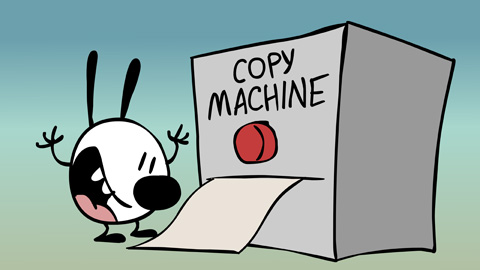
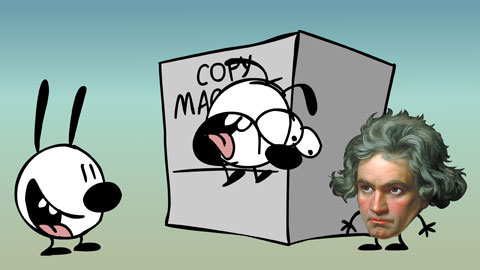
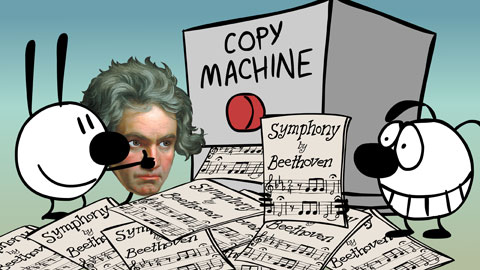
Explanation:
Whenever I speak about Free Culture at schools, I’m asked “what about plagiarism?” Copying and plagiarism are two quite different things. As Mimi demonstrates with the giant Copy Machine, copying a work means copying its attribution too:
just copy the credit along with the work
When people copy songs and movies, they don’t change the authors’ names. Plagiarism is something else: it’s lying. If Copyright has anything to do with plagiarism, it’s that it makes it easier to plagiarize (because works and their provenance aren’t public and are therefore easier to obscure and lie about) and increases incentive to do so (because copying with attribution is as illegal as copying without, and including attribution makes the infringement more conspicuous). American Copyright law does not protect attribution to begin with; it is concerned only with “ownership,” not authorship. Many artists sign their attributions away with the “rights” they sell, which is why it can be difficult to know which artists contributed to corporate works.
I chose Beethoven to illustrate how copyright has nothing to do with preventing plagiarism. All Beethoven’s work is in the Public Domain. Legally, you can take Ludwig van Beethoven’s songs, Jane Austen‘s novels, or Eadweard Muybridge‘s photographs and put any name you want on them. Go ahead! You’re at no risk of legal action. Your reputation may suffer, however, and you definitely won’t be fooling anyone. If anyone has doubts, they can use that same copy machine – the Internet – to sort out who authored what. Lying is very difficult in a public, transparent system. A good analog to this is public encryption keys: their security comes from their publicity.
The song says “always give credit where credit is due,” but in many cases credit is NOT due. For example, how many credits should be at the end of this film? I devoted about two and a half seconds to these credits:
Movie and Song by Nina Paley
Vocals by Bliss Blood
But I could have credited far more. In fact, the credits could take longer than the movie. Here are some more credits:
Ukelele: Bliss Blood
Guitar: Al Street
Recorded by Bliss Blood and Al Street
What about sound effects? Were it not for duration constraints, this would be in the movie:
Sound Effects Design by Greg Sextro
Every single sound effect in the cartoon was made by someone. Should I credit each one? Crash-wobble by (Name of Foley Artist Here). Cartoon zip-run by (Name of Other Foley Artist Here). And so on: dozens of sound effects were used in the cartoon, and each one had an author. What about the little noises Mimi & Eunice make? Not only could the recording engineer be credited, but the voice actor as well (as far as I know, these were both Greg Sextro).
I included a few seconds of Beethoven’s Fifth Symphony at the end, which I didn’t credit in the movie. Should I have? Why or why not?
I could credit the characters:
Starring:
Mimi
Eunice
& Special Guest Appearance by
Ludwig van Beethoven
I could be more detailed in crediting myself:
Lyrics and Melody by Nina Paley
Character design: Nina Paley
Animation: Nina Paley
Produced by Nina Paley
Directed by Nina Paley
Edited by Nina Paley
Backgrounds by Nina Paley
Color design by Nina Paley
Layout: Nina Paley
Based on the comic strip “Mimi & Eunice” by Nina Paley
And the funder!
This Minute Meme was funded by a generous grant from the Andy Warhol Foundation for the Visual Arts
I didn’t even make a card for the Minute Memes logo. Should that be in there?
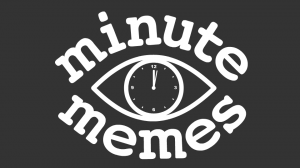
I used a Public Domain painting of Beethoven for the Beethoven character, which is by Joseph Karl Stieler. Who photographed the painting? Who digitized the photograph? Is credit due here?
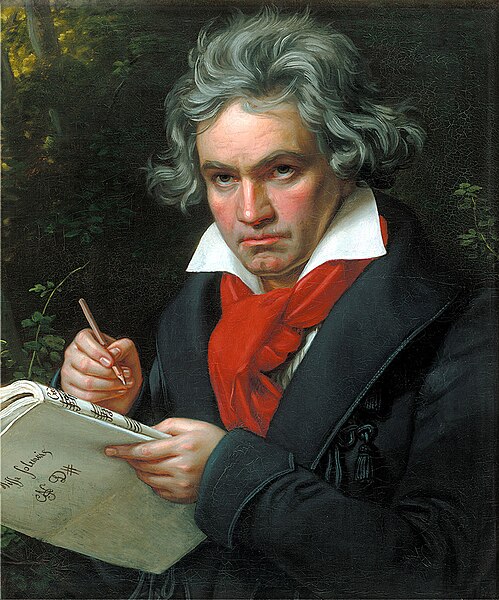
The ass drawing also came from Wikimedia Commons, where it’s credited to Pearson Scott Foresman. But who actually drew it? I have no idea. I doubt that Pearson Scott Foresman could even legally claim the copyright on it to “donate” to Wikimedia in the first place, but there they are, getting credit for it instead of an artist. That’s because copyright is only concerned with “ownership,” not authorship.
Then there’s the software I used, good old pre-Adobe Macromedia Flash. Should I credit the software? What about the programmers who contributed to the software?
I also used a Macintosh computer (I know, I know, when Free Software and Open Hardware come close to doing what my old system does, I’ll be the first to embrace it) and a Wacom Cintiq pen monitor. How many people deserve credit for these in my movie?

Mimi and Eunice themselves were “inspired” by many historical cartoons. Early Disney and Fleischer animations, the “rubber hose” style, Peanuts, this recent cartoon, and countless other sources I don’t even know the names of – but would be compelled to find out, if credit were in fact due. Is it?
And so on. It is possible to attribute ad absurdum. So where is credit due? It’s complicated, the rules are changing, and standards are determined organically by communities, not laws. I had to edit the song for brevity, but I kind of wish I hadn’t excised this line:
A citation shows us where we can get more
of all the good culture that Free Culture’s for
Attribution is a way to help your neighbor. You share not only the work, but information about the work that helps them pursue their own research and maybe find more works to enjoy. How much one is expected to help their neighbor is determined by (often unspoken) community standards. People who don’t help their neighbors tend to be disliked. And those who go out of their way to deceive and defraud their neighbors – i.e. plagiarists – are hated and shunned. Plagiarism doesn’t affect works – works don’t have feelings, and what is done to one copy has no effect on other copies. Plagiarism affects communities, and it is consideration for such that determines where attribution is appropriate.
At least that’s the best I can come up with right now. Attribution is actually a very complicated concept; if you have more ideas about it, please share.


None now. However, I feel attribution should go to the people who’s work is noticed the most. If that’s even possible. 🙂
No license in the video or on this website?!
Well, at least there is one on archive.org.
It’s not clear whether this work is copyrighted or (if it is copyrighted) how this work is licensed to all of us.
This work’s archive.org page says this video is licensed under the Creative Commons Attribution-ShareAlike 3.0 Unported license.
The footer on this page at QuestionCopyright.org says “our content is released to the public and can be considered to be in the public domain: you may copy, share, excerpt, modify, and distribute modified versions of this and other pages from QuestionCopyright.org”.
Would someone with the appropriate authority please correct this confusion?
I didn’t ask the question above but I too noticed the ambiguity.
J.B. Nicholson-Owens
mail@digitalcitizen.info